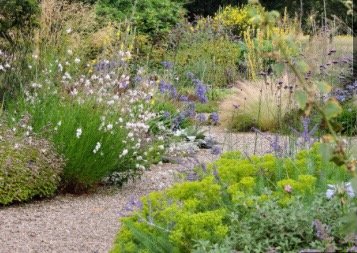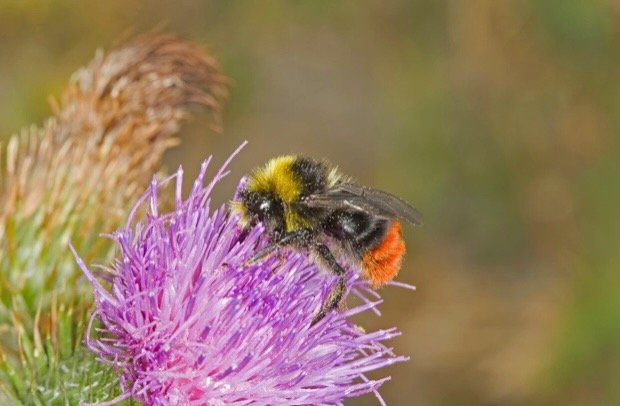May 2023 Garden Design Musings - Gravel Gardens and more
Gravel garden illustration by Jane
Hi Folks!
This month, I thought it might be useful to introduce you to gravel gardens because they really suit the Mediterranean-style- drought tolerant planting that I mentioned in my last article and need little, if any, watering.
I’m going to jump straight into the pros and cons before you decide whether this style of garden is right for you, or not!
On the plus side: Gravel gardens (once established) are low maintenance, need little watering or care and encourage wildlife. They really suit a sunny, well-drained spot, especially if it has sandy or gravelly soil that hasn’t been improved - think of those awkward spots full of builder’s rubble, neglected rockeries or perhaps close to a house wall where little grows, or where the removed base of an old shed or patio used to be. This could be the planting solution you’re looking for.
Plants such as Cistus, Santolina and Phlomis thrive in gravel and provide an abundance of nectar and pollen for our visiting insect friends.
Gravel gardens can be a little bit needy for the first few years until the plants are established and have grown large enough to supress other unwanted plants. You will need to weed for a growing season or three, even with the use of landscape fabric (more on that to follow). They’re also not suited to rich or clay soils or areas with a high-water table.
Lastly, the plants can sometimes have a mind of their own, so if you like everything ordered, this style might not be for you!
Beth Chatto was a great proponent of gravel gardens and ahead of her time as both a horticulturalist and designer, her famous Gravel Garden in Colchester was created on a former car park, it’s never watered and is a sight to behold. View it at www.bethchatto.co.uk
Beth Chatto gravel garden
Creating a gravel garden
· Choose a sunny spot with well-drained soil.
· If you don’t want your plants to self-seed then lay landscape fabric over your soil and cut crosses to insert each plant root ball (without doubt this method is tidier, but here’s the spoiler, given time, weeds will still germinate in the gravel but your specimen plants can’t multiply to crowd them out, which seems a shame). I’m currently in the process of pulling up inherited fabric from our own front garden, to let the plants spread.
· Order your gravel: Bulk bags hold around 1 cubic metre which should cover about 20 square metres laid at 5cm depth.
· Choose local gravel, its often cheaper and is more likely to match your surrounds.
Jane Pearson Garden Design: 07811 367320
Call me to arrange your bespoke plant lists and care instructions, created just for you. Then sit back, relax, and enjoy the show!
Hints & Tips
To stop small new plants becoming swamped by gravel, plant them into a small mound to raise them slightly above the gravels level.
Avoid using limestone chippings if you want to grow acid-loving plants.
To blend in nicely, try to match the gravels colour with other paved or stone structures in your garden.
Choose medium rather than fine grade gravel (20mm or more) It’s easier to walk on and cats wont mistake it for kitty-litter!
The Potting Shed
Gardening tasks to do in May.
Check for nesting birds before clipping your hedges
Lift and divide overcrowded clumps of daffodils and other spring flowering bulbs
Mow lawns but please consider leaving some areas uncut for wildlife.
Open greenhouse vents & doors on warm days
Get your hoe out and hoe off weeds
Earth up potatoes and (note to self!) promptly plant any remaining
Hold off planting out summer bedding until the end of May, however tempting the sunshine seems, it’s still possible to have late frosts.
No-Mow May!
Take part in Countryfile’s #NoMowMay and see your lawn spring to life with flowers, bees, and other pollinators.
The Countryfile web site suggests that “Gardeners, councils and landowners across the UK are gearing up for No Mow May, letting their lawns, verges and grasslands grow freely to give nature a boost. It's not too late to take part this year – any break from your routine mowing will enable bees, butterflies, and other wildlife to get a much-needed boost this spring. All you have to do is resist the urge to cut the lawn during the month of May- Last year's results showed that gardeners who took part reported up to 250 species of plants, including wild garlic, wild strawberry, declining orchids and the rare meadow flower snakeshead fritillary, flowering within the grasses..” Last year we gave it a try and discovered wild orchids in our lawn. You could cut simple paths through your garden lawn or unleash your creativity .. The possibilities are endless!
Bee on a lawn thistle in no-mow May
Happy Gardening! And remember if you need further advice, please don’t hesitate to contact me to arrange a friendly consultation.






